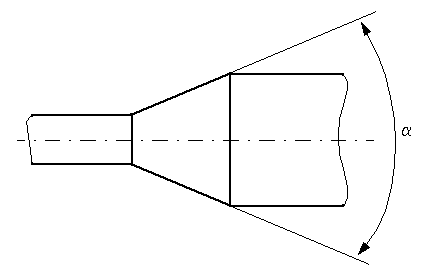Gradual Area Change
(To be removed) Gradual enlargement or contraction
The Hydraulics (Isothermal) library will be removed in a future release. Use the Isothermal Liquid library instead.
For more information on updating your models, see Upgrading Hydraulic Models to Use Isothermal Liquid Blocks.
Libraries:
Simscape /
Fluids /
Hydraulics (Isothermal) /
Local Hydraulic Resistances
Description
The Gradual Area Change block represents a local hydraulic resistance, such as a gradual cross-sectional area change. The resistance represents a gradual enlargement (diffuser) if fluid flows from inlet to outlet, or a gradual contraction if fluid flows from outlet to inlet. The block is based on the Local Resistance block. It determines the pressure loss coefficient and passes its value to the underlying Local Resistance block. The block offers two methods of parameterization: by applying semi-empirical formulas (with a constant value of the pressure loss coefficient) or by table lookup for the pressure loss coefficient based on the Reynolds number.
If you choose to apply the semi-empirical formulas, you provide geometric parameters of the resistance, and the pressure loss coefficient is determined according to the A.H. Gibson equations (see [1] and [2]):
where
KGE | Pressure loss coefficient for the gradual enlargement, which takes place if fluid flows from inlet to outlet |
KGC | Pressure loss coefficient for the gradual contraction, which takes place if fluid flows from outlet to inlet |
Kcor | Correction factor |
AS | Small area |
AL | Large area |
| α | Enclosed angle |

If you choose to specify the pressure loss coefficient by a table, you have to provide a tabulated relationship between the loss coefficient and the Reynolds number. In this case, the loss coefficient is determined by one-dimensional table lookup. You have a choice of two interpolation methods and two extrapolation methods.
The pressure loss coefficient, determined by either of the two methods, is then passed to the underlying Local Resistance block, which computes the pressure loss according to the formulas explained in the reference documentation for that block. The flow regime is checked in the underlying Local Resistance block by comparing the Reynolds number to the specified critical Reynolds number value, and depending on the result, the appropriate formula for pressure loss computation is used.
The Gradual Area Change block is bidirectional and computes pressure loss for both the direct flow (gradual enlargement) and return flow (gradual contraction). If the loss coefficient is specified by a table, the table must cover both the positive and the negative flow regions.
The block positive direction is from port A to port B. This means that the flow rate is positive if fluid flows from A to B, and the pressure loss is determined as .
Assumptions and Limitations
Fluid inertia is not taken into account.
If you select parameterization by the table-specified relationship
K=f(Re), the flow is assumed to be turbulent.
Ports
Conserving
Parameters
References
[1] Flow of Fluids Through Valves, Fittings, and Pipe, Crane Valves North America, Technical Paper No. 410M
[2] Idelchik, I.E., Handbook of Hydraulic Resistance, CRC Begell House, 1994
Extended Capabilities
Version History
Introduced in R2006bSee Also
Elbow | Local Resistance | Pipe Bend | Sudden Area Change | T-junction
